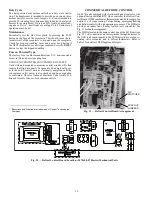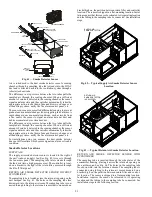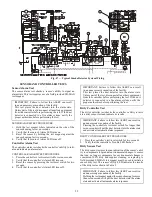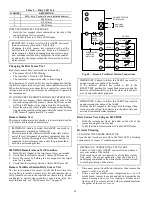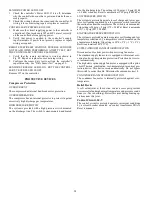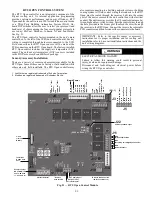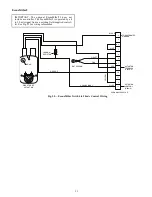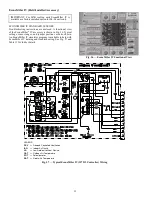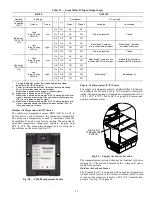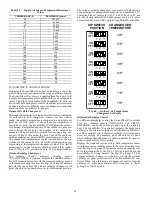
27
Fig. 49 — Sensor Cleaning Diagram
3. Squeeze the retainer clips on both sides of the optic housing.
4. Lift the housing away from the printed circuit board.
5. Gently remove dirt and debris from around the optic plate
and inside the optic housing.
6. Replace the optic housing and sensor cover.
7. Connect power to the duct detector then perform a sensor
alarm test.
Indicators
NORMAL STATE
The smoke detector operates in the normal state in the absence
of any trouble conditions and when its sensing chamber is free
of smoke. In the normal state, the Power LED on both the sen
-
sor and the controller are on and all other LEDs are off.
ALARM STATE
The smoke detector enters the alarm state when the amount of
smoke particulate in the sensor’s sensing chamber exceeds the
alarm threshold value. (See Table 10.) Upon entering the alarm
state:
• The sensor’s Alarm LED and the controller’s Alarm LED
turn on.
• The contacts on the controller’s two auxiliary relays switch
positions.
• The contacts on the controller’s alarm initiation relay close.
• The controller’s remote alarm LED output is activated
(turned on).
• The controller’s high impedance multiple fan shutdown
control line is pulled to ground
Table 10 — Detector Indicators
TROUBLE STATE
The SuperDuct™ duct smoke detector enters the trouble state
under the following conditions:
• A sensor’s cover is removed and 20 minutes pass before it
is properly secured.
• A sensor’s environmental compensation limit is reached
(100% dirty).
• A wiring fault between a sensor and the controller is
detected.
• An internal sensor fault is detected
Upon entering the trouble state:
• The contacts on the controller’s supervisory relay switch
positions. (See Fig. 50.)
• If a sensor trouble, the sensor’s Trouble LED and the con
-
troller’s Trouble LED turn on.
• If 100% dirty, the sensor’s Dirty LED turns on and the
controller’s Trouble LED flashes continuously.
• If a wiring fault between a sensor and the controller, the
controller’s Trouble LED turns on but not the sensor’s.
Fig. 50 — Controller Assembly
NOTE: All troubles are latched by the duct smoke detector. The
trouble condition must be cleared and then the duct smoke detec
-
tor must be reset in order to restore it to the normal state.
RESETTING ALARM AND TROUBLE CONDITION TRIPS
Manual reset is required to restore smoke detector systems to
Normal operation. For installations using two sensors, the duct
smoke detector does not differentiate which sensor signals an
alarm or trouble condition. Check each sensor for Alarm or
Trouble status (indicated by LED). Clear the condition that has
generated the trip at this sensor. Then reset the sensor by press
-
ing and holding the reset button (on the side) for 2 seconds.
Verify that the sensor’s Alarm and Trouble LEDs are now off.
At the controller, clear its Alarm or Trouble state by pressing
and holding the manual reset button (on the front cover) for 2
seconds. Verify that the controller’s Alarm and Trouble LEDs
are now off. Replace all panels.
Troubleshooting
CONTROLLER’S TROUBLE LED IS ON
1. Check the Trouble LED on each sensor connected to the
controller. If a sensor’s Trouble LED is on, determine the
cause and make the necessary repairs.
2. Check the wiring between the sensor and the controller. If
wiring is loose or missing, repair or replace as required.
CONTROLLER’S TROUBLE LED IS FLASHING
1. One or both of the sensors is 100% dirty.
2. Determine which Dirty LED is flashing then clean that sen
-
sor assembly as described in the detector cleaning section.
SENSOR’S TROUBLE LED IS ON
1. Check the sensor’s Dirty LED. If it is flashing, the sensor
is dirty and must be cleaned.
2. Check the sensor’s cover. If it is loose or missing, secure
the cover to the sensor housing.
3. Replace sensor assembly.
CONTROL OR
INDICATOR
DESCRIPTION
Magnetic test/
reset switch
Resets the sensor when it is in the alarm or trouble
state. Activates or tests the sensor when it is in the
normal state.
Alarm LED
Indicates the sensor is in the alarm state.
Trouble LED Indicates the sensor is in the trouble state.
Dirty LED
Indicates the amount of environmental
compensation used by the sensor (flashing
continuously = 100%)
Power LED
Indicates the sensor is energized.
HVAC DUCT
SAMPLING
TUBE
RETAINER
CLIP
OPTIC
PLATE
OPTIC
HOUSING
SENSOR
HOUSING
AIRFLOW
ALARM
POWER
TEST/RESET
SWITCH
TROUBLE
RESET
ALARM
TROUBLE
POWER
Содержание 547K
Страница 94: ...94 APPENDIX D WIRING DIAGRAMS Fig I 547K 04 06 Power Wiring Diagram 208 230 1 60 ...
Страница 95: ...95 APPENDIX D WIRING DIAGRAMS Fig J 547K 04 07 Power Wiring Diagram 208 230 3 60 ...
Страница 96: ...96 APPENDIX D WIRING DIAGRAMS Fig K 5047K 04 07 Power Wiring Diagram 460 575 3 60 ...







